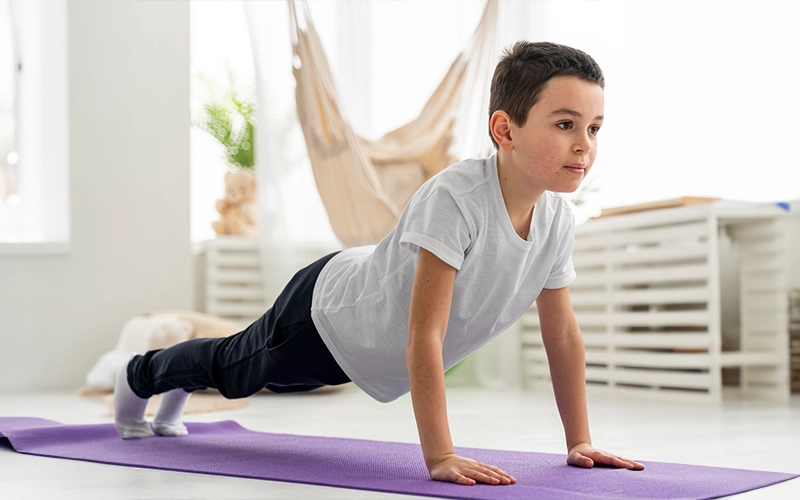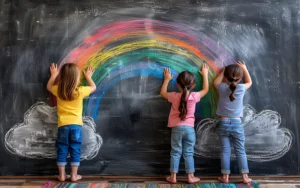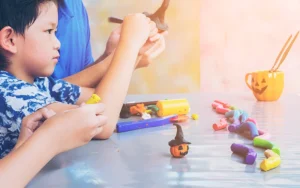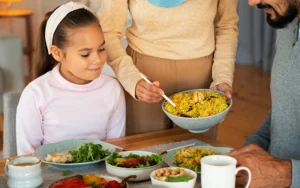Encouraging children to engage in physical activities that bolster mental and physical health is vital in our fast-paced world. Yoga, with its deep-rooted history in enhancing wellness, stands out as a particularly beneficial practice for the young ones. This article explores a variety of engaging and easy yoga poses for kids, aimed at boosting concentration, improving flexibility, and promoting overall well-being. These poses not only support physical health but also contribute to mental and emotional development, making yoga an ideal activity for children.
How to Teach Kids Yoga Poses
Engage with Stories and Themes: Children love stories and imitating animals, which makes animal yoga poses for kids an excellent teaching tool. Begin by telling a story that integrates the pose, such as pretending to be a strong tree in the wind while practicing the Tree Pose (Vrikshasana), or imagining being a stretching cat with the Cat Pose (Marjaryasana).
Utilize Visual Aids: To help children remember the poses and maintain their interest, use visual aids like yoga poses for kids printable charts. These can serve as fun and colorful reminders of the different shapes they can make with their bodies.
Incorporate Playful Games: Making yoga fun by turning it into a game can keep children engaged. For instance, holding a pose longer than their friends in a playful competition can make the activity exciting and enjoyable.
Practice the Poses
Here are some simple and effective yoga poses for kids that are easy to incorporate into any routine
Cat Pose (Marjaryasana) and Cow Pose (Bitilasana): Begin on all fours with hands directly under shoulders and knees under hips. For Cat Pose, exhale as you draw your belly to your spine and round your back toward the ceiling, like a cat stretching. For Cow Pose, inhale as you drop your belly towards the mat, lift your chin and chest, and gaze upward. This combination helps massage the spine and relieves tension in the torso.
Tree Pose (Vrikshasana): Start by standing straight with arms at your sides. Shift your weight to your left leg, and place the sole of your right foot inside your left thigh, keeping your hips facing forward. Once balanced, bring your hands into a prayer position in front of your chest, or raise them over your head like branches. This pose helps improve balance and stability while strengthening the legs and back.
Warrior II (Virabhadrasana II): From a standing position, step your feet wide apart. Turn your right foot out 90 degrees and your left foot in slightly. Extend your arms out to the sides and bend your right knee, ensuring it’s over your ankle. Look over your right hand, keeping your torso perpendicular to the floor. This pose increases stamina, strengthens the legs and arms, and opens up the hips and chest.
Butterfly Pose (Baddha Konasana): Sit with your spine straight and legs extended. Bend your knees and bring the soles of your feet together, pulling them as close to your body as you can. Hold your feet with your hands and gently flap your knees up and down like the wings of a butterfly. This pose helps improve flexibility in the groin and hips, and can also calm the mind and alleviate stress.
Frog Pose: Begin by squatting down, then widen your thighs more than your torso, and ensure your feet are turned out. Lower your body down to the point where your hands are on the floor in front of you, elbows bent. Press your hips forward and back to deepen the stretch in your inner thighs and groin. Kids usually enjoy this pose as it mimics a frog’s leap, and it helps improve flexibility and lower body strength.
Mental Health Benefits of Yoga for Kids
Boosts Concentration:Engaging in yoga helps children improve their concentration and focus through mindful breathing and balancing techniques.
Relieves Stress:Simple yoga poses provide a physical outlet for stress and anxiety, helping children manage their emotions more effectively.
Builds Confidence and Self-esteem:As children master new poses, they feel accomplished, which boosts their confidence and self-esteem.
Additional Benefits and Tips
Promotes Flexibility and Strength: Regular yoga practice enhances both flexibility and strength in children by using their body weight in various poses.
Establish a Routine:Consistency is key in yoga. Setting a regular schedule helps children integrate yoga into their daily lives, making it a natural part of their routine.
Encourage Group Sessions:Children often enjoy activities more with their peers. Organize small group sessions to make yoga more enjoyable and socially enriching.
Foster Creativity: Allow children the freedom to invent their own poses or modify existing ones. This not only keeps them engaged but also encourages creativity.
Introducing yoga to children through fun, simple poses can help develop a lifelong appreciation for this healthy practice. By making yoga a regular part of children’s routines, they not only gain immediate physical and mental benefits but also acquire tools to manage stress and challenges throughout their lives. This balanced approach ensures that as they grow, they maintain a healthy relationship with their bodies and minds.
FAQs
A: For children, the duration for holding yoga poses can vary depending on their age, flexibility, and level of interest. Typically, younger children (ages 3-7) might only hold a pose for 10 to 20 seconds, as their attention span is shorter. Older children (ages 8 and up) can begin to hold poses for anywhere from 20 seconds to a minute. The key is to keep the practice enjoyable and stress-free, without pushing them to hold poses for too long, which might lead to disinterest or discomfort.
A: To do yoga poses for kids, create a fun and inviting atmosphere. Use playful narratives and mimic animals or nature, which many poses are named after. Always begin with simple stretches to warm up the body. Show each pose first and then help them into the pose, ensuring they understand how to align their body correctly. Keep instructions clear and use visual aids if available. Encourage them to breathe normally throughout the pose, and most importantly, ensure they know it’s okay to fall out of a pose and try again.
A: The Child Pose, or Balasana, is a gentle resting pose that is often used as a counterpose to more active exercises. For children, this pose has a calming effect on the brain, helping to relieve stress and fatigue. It also helps to stretch the hips, thighs, and ankles, and can reduce back and neck pain when done with the head and torso supported. It's particularly useful for calming the mind and body after energetic activities, making it a beneficial tool for managing hyperactivity and anxiety
A: One of the easiest and most engaging forms of yoga for kids involves animal-themed poses, such as Cat Pose, Dog Pose, and Cobra Pose. These poses are not only simple but also allow children to use their imaginations, which makes the practice more enjoyable. For instance, the Cat-Cow stretch is a gentle flow between two poses that warms the body and brings flexibility to the spine. Similarly, the Downward-Facing Dog is another straightforward pose that helps to energize and rejuvenate the body, making it a favorite among children of all ages.









